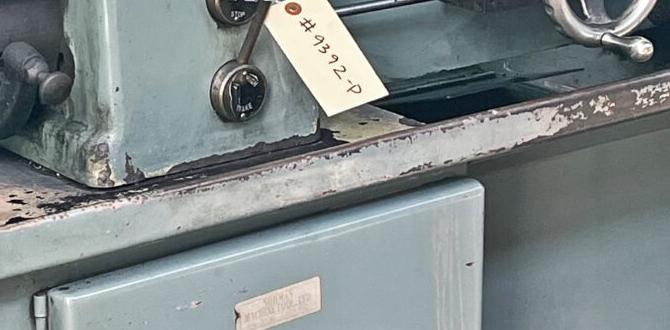Carbide end mills are your best friend for precisely cutting brass on a mill. They offer superior hardness and sharpness, leading to cleaner edges and faster work compared to HSS, especially for hobbyists and beginners.
Working with brass on a milling machine can sometimes feel a bit sticky. You might notice your cuts aren’t as clean as you’d like, or maybe your tool chips seem to be welding themselves to the cutter. This is a common challenge for anyone new to milling softer metals like brass. The good news is that the right tooling makes a world of difference. Today, we’re diving into why a carbide end mill, particularly a specific type, is an absolute game-changer for anyone wanting to achieve smooth, precise, and effortless brass milling. We’ll guide you through what makes them so special and how to pick the perfect one for your projects. Get ready to see your brass work transform!
Why Brass Gives Machinists a Hard (and Sticky) Time
Brass is a fantastic material to work with for many projects because it’s relatively soft, easy to machine, and has a beautiful golden luster. However, this softness can also be its downfall when it comes to milling. Brass has a tendency to be “gummy,” meaning it can smear and deform rather than cleanly shearing away. This gummy nature leads to a few common problems:
- Chip Weldi
ng: The soft brass can actually stick, or “weld,” to the cutting edges of your tool. This builds up on the cutter, making it dull faster and causing rougher cuts. - Poor Surface Finish: When chips weld to the tool, they drag through the material, leaving behind a poor, smeared, or even torn surface finish.
- Tool Breakage: Over time, the buildup of material and the increased cutting forces can lead to premature tool wear or even breakage, especially with less robust tool materials.
- Slower Cutting Speeds: To combat these issues, machinists often have to slow down their cutting speeds significantly, making the milling process less efficient.
These issues are amplified when using the wrong type of cutting tool. Traditional High-Speed Steel (HSS) end mills, while versatile, can struggle with the “gummy” nature of brass. They work, but they often require careful feeds, speeds, and copious amounts of lubrication (coolant) to keep the brass from sticking.
Enter the Carbide End Mill: Your Brass Machining Hero
Carbide, specifically Tungsten Carbide, is a material known for its extreme hardness and wear resistance. This makes carbide end mills exceptionally well-suited for a wide range of materials, and brass is no exception. In fact, for milling brass, a well-chosen carbide end mill is often considered essential.
Here’s why carbide shines when it comes to brass:
- Superior Hardness: Carbide is significantly harder than HSS. This exceptional hardness allows it to maintain its cutting edge longer, resisting wear and deformation even when cutting sticky materials like brass.
- Sharp Cutting Edges: Carbide can be manufactured with incredibly sharp cutting edges. Sharpness is crucial for a clean cut, reducing the tendency for brass to smear and making it easier for chips to clear away.
- Heat Resistance: While brass isn’t known for producing extreme heat, carbide’s ability to handle higher temperatures than HSS means it can withstand the friction generated during cutting more effectively, further preserving its edge.
- Faster Cutting Speeds: Due to their superior properties, carbide end mills often allow for faster feed rates and spindle speeds without sacrificing finish, making your milling tasks more efficient.
- Lower Runout Potential: ‘Runout’ is the wobble a tool makes as it spins. Tools with very low runout cut more accurately. Higher quality carbide tools, especially those with standardized shanks like 6mm or 1/8 inch, are often manufactured to tighter tolerances, meaning less wobble and more precision.
Choosing the Right Carbide End Mill for Brass
Not all carbide end mills are created equal, and selecting the right one for brass milling is key to unlocking those smooth, clean cuts. We’re focusing on a specific type that offers the best balance of performance and accessibility for beginners and hobbyists. When we talk about “carbide end mill 1/8 inch 6mm shank standard length for brass low runout,” we’re describing a very specific, and highly effective, tool.
Key Features to Look For:
- Material: Tungsten Carbide. This is the standard for high-performance end mills.
-
Number of Flutes: For brass, tools with 2 or 3 flutes are generally preferred.
- 2-Flute: Excellent for chip evacuation. The larger chip gullets (the space between the flutes) mean chips can escape more easily, crucial for gummy materials like brass. This reduces the chance of chip welding.
- 3-Flute: Offers a slightly better surface finish than a 2-flute due to more cutting edges engaging the material. However, chip evacuation can be slightly more challenging than with a 2-flute. For brass, a 2-flute is often the go-to for its chip clearing ability.
- Coating: While not always necessary for brass, simple coatings like Uncoated (bright finish) or a Titanium Nitride (TiN) coating can offer marginal benefits in terms of lubricity and wear resistance. Avoid highly specialized coatings designed for extreme heat or abrasive materials, as they might not be cost-effective or necessary for brass. Uncoated is often perfectly fine and cost-effective.
- Helix Angle: A standard helix angle (around 30 degrees) is suitable. Some specialized tools have high helix angles for aggressive material removal, but a standard angle is great for general brass milling.
-
Shank Diameter: We’re talking about common, smaller diameters suitable for hobbyist and desktop mills.
- 1/8 inch (3.175mm): A very common size for smaller, precision mills, especially those used for PCB engraving or small parts.
- 6mm (0.236 inches): Another very common size in metric-focused or professional hobbyist machines.
Using a standard shank size ensures a secure fit in common collets and tool holders.
- Length: “Standard length” means it’s not an extended reach tool. For most brass milling tasks on smaller machines, a standard length cutter provides rigidity and minimizes deflection.
-
Low Runout: This is critical! Runout is the deviation from a perfect rotation. High runout causes the cutter to wobble, leading to inconsistent cuts, poor finish, chatter, and tool breakage. Tools specifically manufactured for low runout will provide a much more stable and precise cut. This is often a hallmark of quality manufacturing.
What is Runout and Why is it Important?
Imagine a perfectly straight pencil spinning on a table. Now imagine that pencil is bent slightly. As it spins, the tip wobbles. In milling, your end mill should spin perfectly true. Runout is that wobble. Low rotational runout on your end mill and its holder is crucial because:
- Precision: A tool with low runout cuts exactly where you tell it to, resulting in dimensional accuracy.
- Surface Finish: Consistent cutting action from a tool running true leads to a smoother, cleaner surface finish.
- Tool Life: Excessive runout puts uneven stress on the cutting edges, leading to premature wear and breakage.
- Reduced Vibration (Chatter): Wobble often translates to chatter, a noisy vibration that degrades the workpiece surface and stresses the machine.
Reputable manufacturers of precision tooling strive to minimize runout in their manufacturing process. You can learn more about the impacts of tool runout on machining accuracy from resources like Mayr power transmission systems, which highlights how critical toolholding precision is.
Example Table: Comparing 2-Flute vs. 3-Flute for Brass
Here’s a quick comparison to help you decide which flute count might be best for your brass milling needs:
| Feature | 2-Flute for Brass | 3-Flute for Brass |
|---|---|---|
| Chip Evacuation | Excellent – Larger gullets handle sticky chips well. | Good – Not as much clearance as 2-flute. |
| Surface Finish | Good – Can produce clean cuts with proper settings. | Excellent – More cutting edges provide a smoother finish. |
| Material Removal Rate (MRR) | Good – Can plunge and cut efficiently. | Very Good – Can often push harder due to more cutting edges. |
| Best Use Case | General milling, slotting, profiling, especially when chip buildup is a concern. | Profiling, facing, where a superior surface finish is paramount and chip evacuation is manageable. |
| Recommendation for Beginners | Often the safest and most forgiving choice for brass. | A solid choice if you’re mindful of chip clearing. |
Essential Setup: What You’ll Need
Before you even think about cutting brass, ensure you have the right setup. This isn’t just about the end mill; it’s about the entire system working together.
- Milling Machine: Whether it’s a benchtop CNC, a manual mill, or even a powerful rotary tool with a milling attachment, ensure it’s capable of holding your end mill securely and running at appropriate speeds.
- Collet or Tool Holder: A high-quality collet system is essential for holding your end mill. For the 1/8 inch or 6mm shank sizes, you’ll need the corresponding collet. Ensure your collets are clean and in good condition to minimize runout. For larger machines, a milling chuck or dedicated tool holder works. The key is a secure, concentric grip.
- Workholding: Your brass workpiece needs to be held securely. This could be in a vise, clamped to a fixture plate using T-nuts and clamps, or directly attached to the machine bed if appropriate. Workpiece movement during milling is dangerous and leads to poor results.
- Measuring Tools: Calipers and a ruler are essential for accurate setup and measurement.
-
Safety Gear:
- Safety Glasses: Non-negotiable. Always wear impact-resistant safety glasses.
- Hearing Protection: Milling can be noisy.
- Gloves (Optional, with caution): Be very careful wearing gloves around rotating machinery. Some machinists prefer to wear tight-fitting gloves, others avoid them entirely. Ensure no loose parts can get caught.
- Dust Mask: When machining metals, fine dust particles are produced.
-
Lubrication/Coolant (Recommended): While brass can sometimes be milled dry, using a lubricant or coolant significantly helps.
- Cutting Fluid/Oil: A specific cutting fluid designed for brass or general-purpose metal machining can help with chip evacuation and cutting efficiency.
- Mist Coolant System: For CNC machines, a mist coolant system provides a fine spray of coolant, keeping the tool and workpiece cool and washing away chips.
- WD-40 or similar: In a pinch, a light spray of WD-40 can help, but dedicated cutting fluids are better.
You can find excellent beginner guides on machining lubrication from reputable sources like Haas Automation’s maintenance tips.
Step-by-Step: Milling Brass with Your Carbide End Mill
Now that you have your tool and setup ready, let’s get to the actual milling. We’ll aim for a simple, common operation like profiling a shape or cutting a slot. Remember, these are starting points; always be prepared to make adjustments based on how the machine and material are behaving.
Step 1: Secure Your Workpiece
Clamp your brass piece firmly in your vise or onto your machine table. Ensure it cannot move at all. If milling a profile, make sure the edge you’ll be following is accessible and clean.
Step 2: Install the End Mill
Insert your 1/8 inch or 6mm shank carbide end mill into the appropriate collet or tool holder. Tighten it securely. If using a collet chuck, ensure the shank of the end mill is seated correctly within the collet before tightening.
Step 3: Set Your Zero Point (Origin)
This is crucial for accuracy. You’ll need to tell your milling machine where to start cutting.
- X and Y Axis: Use an edge finder or a dial indicator to find the exact edge of your workpiece. Jog your machine’s spindle over the edge until the indicator shows you’re precisely at the desired starting point for your X and Y coordinates. Set your machine’s origin (G54 for CNC) at this point.
- Z Axis: To set your Z-zero, you can use a “Z-touch” tool, a simple piece of paper (by carefully lowering the spindle until the paper just catches), or a height gauge. Place your touch tool on the surface of the workpiece where you want to start cutting and lower the spindle until it registers. Set your Z-zero.
For CNC users, understanding your machine’s work coordinate systems is vital. Resources from educational institutions like The Ohio Manufacturing Extension Partnership can provide detailed insights into CNC setup.
Step 4: Apply Lubrication (If Using)
Start your mist coolant system or apply a light stream of cutting fluid to the area where the cut will occur. This is especially important for brass.
Step 5: Set Your Cutting Parameters (Feeds and Speeds)
This is where your carbide end mill truly shines. Brass is soft, so you don’t need extremely slow speeds. For a 1/8 inch or 6mm carbide end mill, here are some starting points. Always start conservatively and listen to the machine!
Suggested Starting Feeds and Speeds for Brass (Carbide End Mill)
| Tool Diameter | Spindle Speed (RPM) | Feed Rate (IPM / mm/min) | Depth of Cut (DOC) | Width of Cut (WOC) | Flutes |
|---|---|---|---|---|---|
| 1/8 inch (3.175mm) | 10,000 – 20,000 RPM | 10 – 25 IPM (250 – 635 mm/min) | 0.005 – 0.020 inches (0.127 – 0.508 mm) | 0.005 – 0.050 inches (0.127 – 1.27 mm) | 2 or 3 |
| 6mm | 10,000 – 20,000 RPM | 250 – 635 mm/min (approx. 10-25 IPM) | 0.127 – 0.508 mm | 0.127 – 1.27 mm | 2 or 3 |
Important Notes on Speeds and Feeds:
- These are general guidelines. Actual values depend on the specific brass alloy, machine rigidity, coolant usage, and the exact cutter geometry.
- It’s always better to start too slow and too shallow and increase gradually if the cut is smooth and chips are clearing well.
- Chip Load: A key concept is “chip load,” which is the thickness of the material being removed by each cutting edge as the tool rotates. For brass with a 2-flute carbide end mill, a chip load of around 0.001 – 0.003 inches (0.025 – 0.076 mm)






